





In part 2 of this 3 part series, I will discuss those hardy (zone 5 and colder) shrubs whose main claim-to-fame is their red to purplish foliage. These shrubs are wonderful additions to the landscape, complimenting blue, purple and red flowers or contrasting with yellows, oranges and white. They are available in a wide variety of sizes, so any garden can utilize examples from this group of shrubs.
In part 1 of Hardy Deciduous Shrubs for Colorful Foliage, I discussed the merits of those shrubs with yellow foliage. Part 2 of this 3 part series will discuss the best red to purple-foliaged shrubs for zones 5b and colder. I guess the ultimate shrub in this category would be the various dwarf forms of Japanese maple but because they are just hardy to zone 5b and thus borderline hardy for most northern gardeners, I will not include them here. As with the yellow-foliaged shrubs, it is perhaps easiest to describe the shrubs in alphabetical order, starting with Berberis thunbergii or Japanese barberry. As mentioned in part 1, barberry have only recently been available in the landscape trade. For many years there was a restriction on selling them as they were thought to be an alternate host for wheat rust. As it happens, this particular species is fine (although some barberry are indeed alternate hosts). Even before the ban, there were purple-leaved cultivars of Japanese barberry, the old standard being ‘Atropurpurea' (purple) ‘Golden Ring' (purple with thin yellow rim) and ‘Red Chief' (reddish-purple). All of these can reach 1.5-2 m. Recently there has been a wave of new purple-leaved cultivars. In the 1.5-2 m range are ‘Angel Wings', ‘Crimson Velvet', ‘Rose Glow' and ‘Sheridan's Red'. In the 1 to 1.5 m range are ‘Monomb' (aka Cherry Bomb), ‘Royal Cloak', ‘Admiration' and ‘Royal Burgundy'. With a narrow, upright habit 1.5 m or taller are ‘Helmond's Pillar', ‘Marshall's Upright' and ‘Red Pillar'. Dwarf (under 1 m) mounding selections suitable for rockeries and the front of the border include ‘Crimson Pygmy', ‘Bagatelle', ‘Bailtwo' (aka Burgundy Carousel), ‘Concorde', ‘Goruzam' (aka Golden Ruby) and ‘Bailone' (aka Ruby Carousel). These all produce red, tear-drop shaped fruit but they are not really noticeable until leaf drop. Most of these purple-leaved varieties turn orange to red in the fall. They are all rated for zone 4.

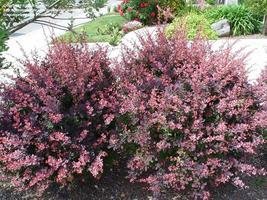
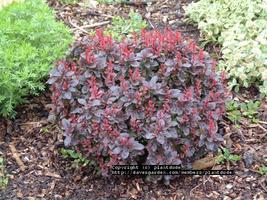
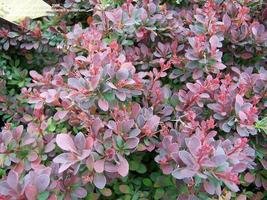
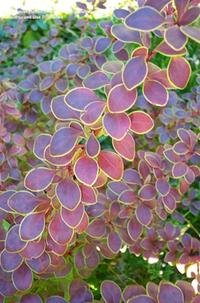
Examples of purple-leaved barberries include 'Royal Cloak', Rose Glow', 'Concorde', 'Royal Burgundy' and 'Gold Ring'
Smokebush, Cotinus coggygria, is rated for zone 5 with plants known to survive to zone 4b, so it sits on the fence for this article. There are several purple-leaved forms, which can reach 5m. In borderline hardy regions, they will often experience die-back but often will re-flush at the base, resulting in much smaller plants. There are five popular cultivars: ‘Nordine', 'Purple Supreme', ‘Norcutt's Variety', ‘Royal Purple', ‘Velvet Cloak' and 'Grace' (the last one is C. obovatus X C. coggygria 'Velvet Cloak'). Of these, ‘Nordine' and 'Purple Supreme' are the hardiest and most likely to survive in zone 4b.
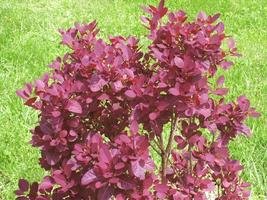
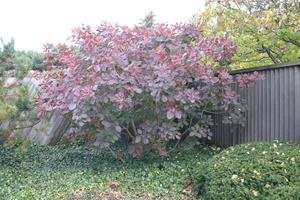
Two examples of purple-leaved smokebush are 'Royal Purple' and 'Grace'
Ninebark, Physocarpus opulifolius, was traditionally more well-known for its golden-leaved cultivars, but recently, there have been several purple-leaved selections, the first of importance being ‘Diablo'. The leaf colour of ‘Diablo' is perhaps best described as chocolate-purple, but looks almost black from a distance. It is certainly not the vibrant purple of purple-leaved sand cherry or purple barberries. ‘Diablo' can reach 3 m. Crossing ‘Diablo' to the cultivar ‘Nana' resulted in ‘Seward' (aka Summer Wine) which is a 1.5-2 m version of ‘Diablo'. Crossing ‘Diablo' to ‘Dart's Gold' resulted in ‘Mindia' (aka Coppertina) which is also 1.5-2 m but the leaves are copper-red rather than the darker tones of ‘Diablo' or ‘Seward'. Ninebark are rated for zone 2-3 and are reasonably drought-tolerant once established.
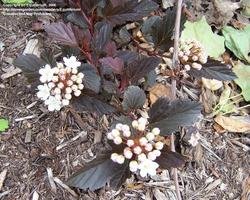
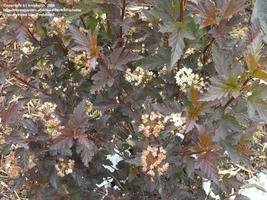
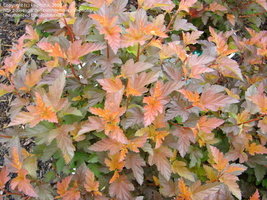
Illustrated above are the three standard purplish ninebarks; 'Diablo', 'Summer Wine' and 'Coppertina'
Perhaps the most popular purple-leaved shrub in cold climates is the purple-leaf sand cherry, Prunus X cistena. The leaves are shiny purple and in spring, they produce contrasting light pink blossoms. This hybrid can reach 2.5 m. A better selection is the compact version ‘Crimson Dwarf' which matures at 1.2 m. The main drawback of this plant is that it is short-lived and usually start to decline after 10-15 years. Both are rated for zone 3 and are quite drought-tolerant once established.
Many roses have leaves that emerge shiny red but become green once they mature. However, the species rose, Rosa rubrifolia, has unique blue-tinted, purple foliage all season. This rose has single, fragrant, bright pink flowers in early summer which provide a beautiful contrast against the foliage. This rose will reach 2-3 m and is super-hardy, being rated for zone 2. This rose will perform admirably in shade but flowering will be scarce.
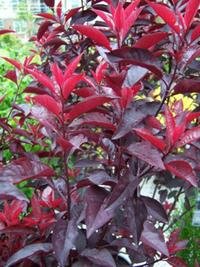
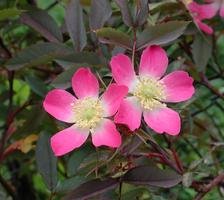
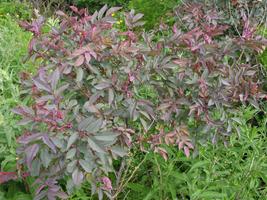
Pictured above are Prunus X cistena and Rosa rubrifolia
Black elderberry, Sambucus nigra, is a tall shrub (to 5m) that has some recent purple-leaved selections. The old standard purple-leaved form was ‘Purpurea' which leafed out purple but turned purplish-green in summer. From ‘Purpurea' came ‘Guincho Purple' with darker purple foliage and then ‘Gerda' (aka Black Beauty), released in the US in 2004, with very dark purple-black leaves on a more compact plant 2-3 m. And most recently (released in 2006) has come the delicate and exquisite ‘Eva' (aka Black Lace) with finely-cut, purple-black leaves, a wonderful substitute for a Japanese maple in colder regions. All of these purple-leaved selections have pink flowers. Although rated for zone 5a, if heavily mulched, they will survive zone 4 and essentially re-sprout from the base each spring (acting almost herbaceous). Elderberries, as a group, prefer evenly moist soil. Full sun will develop the most intense purple colour.
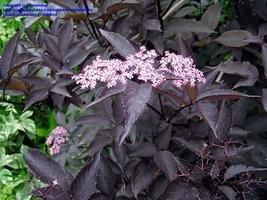
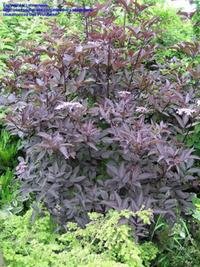
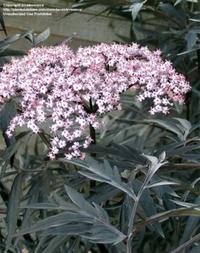
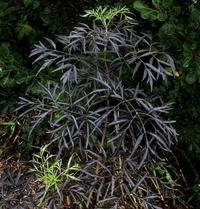
Illustrated above are Sambucus nigra 'Black Beauty' and 'Black Lace'
The last important group of purple-foliaged shrubs are selections of Weigela florida. Like barberry and elderberries, there has been much work done on improving the purple-leaved forms of this shrub. All the modern day cultivars had their beginnings with the cultivar ‘Follis Purpureis', also known as ‘Nana Purpurea' or ‘Java Red'. This older selection has a low spreading habit to about 1 m. The foliage starts off chocolate-purple but becomes more greenish-purple as the season progresses. Plants produce masses of dark pink flowers. Even though ‘Tango' and ‘Victoria' have purple-tinted foliage, the best selections are ‘Alexandra' (aka Wine and Roses), 'Dark Horse' and ‘Elvera' (aka Midnight Wine). The former two have glossy, chocolate-purple foliage and rosy-pink flowers on a dwarf shrub 60-75 cm. The latter has similar foliage and flowers but is even more dwarf, a mere 20-30 cm! It is a wonderful addition to the rock garden or front of the border. Weigela are rated for zone 4 and prefer full sun. They are reasonably drought-tolerant once established.
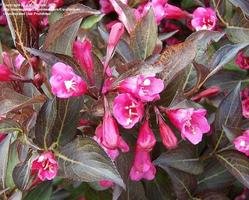
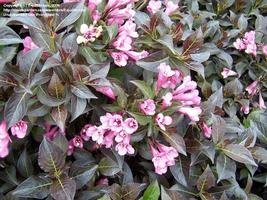
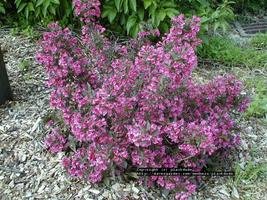
Selections of purple-leaved Weigela include 'Wine and Roses', 'Dark Horse' and 'Tango'
In the last installment of this series I will discuss those hardy deciduous shrubs whose leaves are variously edged or splashed with white, cream or yellow on a green background i.e. the variegated shrubs.
I have many people to tank for the use of their pictures throughout this article: Equilibrium (Berberis 'Royal Burgundy', Weigela 'Dark Horse', Weigela 'Wine and Roses', Prunus X cistena foliage and Physocarpus 'Diablo'), growin (Berberis 'Gold Ring'), hczone6 (Cotinus 'Royal Velvet'), kachinagirl (Berberis 'Rose Glow'), KevinMC (Cotinus 'Grace'), kniphofia (Physocarpus 'Summer Wine' and 'Coppertina'), plantdude (Berberis 'Concorde' and Weigela 'Tango'), rcn48 (Sambucus 'Black Lace' foliage) and stevenova (Sambucus 'Black Beauty' and 'Black Lace' flowers)
Copyright © www.100flowers.win Botanic Garden All Rights Reserved